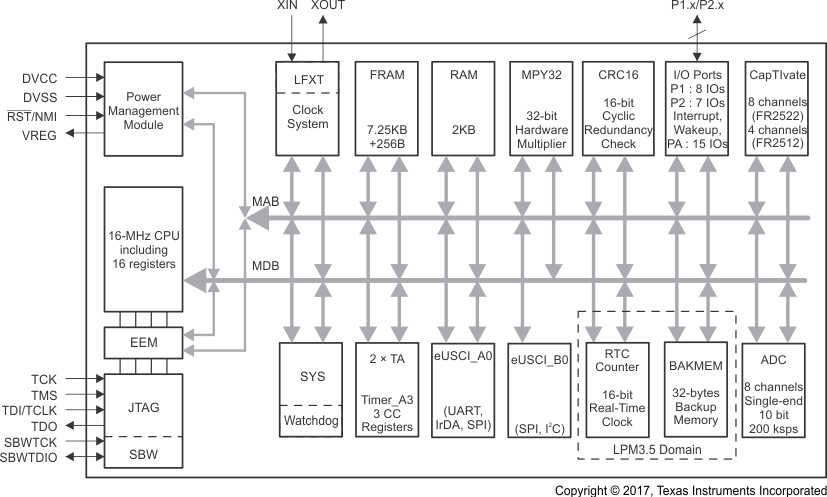JAJSEE2C January 2018 – December 2019 MSP430FR2512 , MSP430FR2522
PRODUCTION DATA.
- 1デバイスの概要
- 2改訂履歴
- 3Device Comparison
- 4Terminal Configuration and Functions
-
5Specifications
- 5.1 Absolute Maximum Ratings
- 5.2 ESD Ratings
- 5.3 Recommended Operating Conditions
- 5.4 Active Mode Supply Current Into VCC Excluding External Current
- 5.5 Active Mode Supply Current Per MHz
- 5.6 Low-Power Mode (LPM0) Supply Currents Into VCC Excluding External Current
- 5.7 Low-Power Mode (LPM3, LPM4) Supply Currents (Into VCC) Excluding External Current
- 5.8 Low-Power Mode (LPMx.5) Supply Currents (Into VCC) Excluding External Current
- 5.9 Typical Characteristics - Low-Power Mode Supply Currents
- Table 5-1 Typical Characteristics – Current Consumption Per Module
- 5.10 Thermal Resistance Characteristics
- 5.11 Timing and Switching Characteristics
-
6Detailed Description
- 6.1 Overview
- 6.2 CPU
- 6.3 Operating Modes
- 6.4 Interrupt Vector Addresses
- 6.5 Bootloader (BSL)
- 6.6 JTAG Standard Interface
- 6.7 Spy-Bi-Wire Interface (SBW)
- 6.8 FRAM
- 6.9 Memory Protection
- 6.10
Peripherals
- 6.10.1 Power-Management Module (PMM)
- 6.10.2 Clock System (CS) and Clock Distribution
- 6.10.3 General-Purpose Input/Output Port (I/O)
- 6.10.4 Watchdog Timer (WDT)
- 6.10.5 System (SYS) Module
- 6.10.6 Cyclic Redundancy Check (CRC)
- 6.10.7 Enhanced Universal Serial Communication Interface (eUSCI_A0, eUSCI_B0)
- 6.10.8 Timers (Timer0_A3, Timer1_A3)
- 6.10.9 Hardware Multiplier (MPY)
- 6.10.10 Backup Memory (BAKMEM)
- 6.10.11 Real-Time Clock (RTC)
- 6.10.12 10-Bit Analog-to-Digital Converter (ADC)
- 6.10.13 CapTIvate Technology
- 6.10.14 Embedded Emulation Module (EEM)
- 6.11 Input/Output Diagrams
- 6.12 Device Descriptors
- 6.13 Memory
- 6.14 Identification
- 7Applications, Implementation, and Layout
- 8デバイスおよびドキュメントのサポート
- 9メカニカル、パッケージ、および注文情報
1.4 機能ブロック図
機能ブロック図を、Figure 1-1に示します。
 Figure 1-1 機能ブロック図
Figure 1-1 機能ブロック図 - このMCUには、DVCCおよびDVSSの1つのメイン電源ペアがあり、デジタルとアナログの両方のモジュールへ電力を供給します。バイパスおよびデカップリング・コンデンサとしては、それぞれ4.7µF~10µFおよび0.1µFで、精度±5%が推奨されます。
- VREGは、CapTIvateレギュレータのデカップリング・コンデンサです。必要なデカップリング・コンデンサの推奨値は1µFで、最大ESRは200mΩ以下です。
- P1およびP2にはピン割り込み機能があり、LPM3.5およびLPM4を含むすべてのLPMからMCUをウェイクアップできます。
- 各Timer_A3には3つのキャプチャ/比較レジスタがあります。外部的に接続されているのはCCR1およびCCR2のみです。CCR0レジスタは、内部的な期間のタイミングと割り込みの生成にのみ使用できます。
- LPM3およびLPM4モードで、他のペリフェラルがオフの間もCapTIvateモジュールは機能できます。